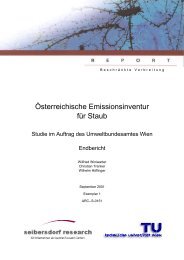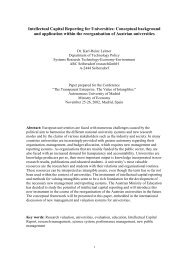ALPMON FINAL REPORT - ARC systems research
ALPMON FINAL REPORT - ARC systems research
ALPMON FINAL REPORT - ARC systems research
You also want an ePaper? Increase the reach of your titles
YUMPU automatically turns print PDFs into web optimized ePapers that Google loves.
Contract ENV4-CT96-0359 <strong>ALPMON</strong><br />
3.3.1 Set-up and harmonisation of parameters<br />
The set-up of the parameters was carried out using a comprehensive list of single parameters and the<br />
respective classes. As the requirements of the national customers were used as input for the<br />
parameter set-up, the used level of detail ensures, that all requirements of the local customers could<br />
be met. The use of single parameters instead of predefined landuse-classes enables the flexible<br />
assignment of parameter classes to user-oriented classes.<br />
The requirements of the Alpine Monitoring System (AMS) of the Alpine Convention were included only<br />
partially in the parameter set-up, because only a first draft of AMS-indicators was available at that time.<br />
Therefore, <strong>ALPMON</strong> oriented the parameter set-up according to FIRS (EUR 16416). In some cases,<br />
AMS-indicators are fully addressed by <strong>ALPMON</strong> parameters. Some of the AMS-indicators deal with<br />
topics, which cannot be assessed with remote sensing alone. The AMS-indicators do not include the<br />
<strong>ALPMON</strong>-parameters 'crown coverage', 'vegetation coverage' and 'natural age class'. These<br />
parameters are of great importance to the protection function of the forest as well as for the planning of<br />
regeneration measures. The AMS-indicators do not address non-forest areas, which are included in<br />
<strong>ALPMON</strong>.<br />
As the collection of ground truth information in WP 4 proved, the parameter list can be used<br />
successfully. If the AMS-indicators were ready before the start of <strong>ALPMON</strong>, they would have been<br />
considered completely.<br />
3.3.2 Collecting of ground information and verification of classification results<br />
Work packages WP4 Ground Truthing and WP10 Verification are summarised collectively, as they are<br />
interrelated closely. The verification of classified satellite data is very much dependent on the<br />
reference, with which the verification is done. The classification accuracy, which results from the<br />
verification, is dependent on how the reference is sampled, its spatial distribution and its<br />
representativity of the categories of interest. Since WSL co-ordinated these two packages, they are<br />
evaluated together.<br />
Ground truth information (WP4) was collected by all partners on the basis of infrared aerial<br />
photographs, which were additionally verified with field surveys. This approach was recommended for<br />
supporting the delineation of suitable training areas for the digital classification and for verification. The<br />
parameters set up in WP 3 were applied successfully. It must be stated that the applied sampling<br />
strategies for ground truth information differed from partner to partner, which directly influences the<br />
outcome of the verification. Subjectivity is induced by the choice of reference data sampling size and<br />
strategy (Smits et al., 1999).<br />
The verification (WP10) of classified satellite data varied somewhat from partner to partner. During the<br />
Partner Meetings in Freiburg (December 1998) and Munich (June 1999), it was decided to carry out<br />
pixel- and stand-wise verification. In general, better statistical accuracy measures were produced for<br />
the stand-wise verification method. Exceptions arose due to the selectively small number of stands<br />
available.<br />
3.3.3 Geocoding<br />
The integration of different sensors and the connection of the remote sensing data to ancillary<br />
information of <strong>ALPMON</strong> put high demands on the geometric accuracy of these data. Thus, the<br />
geometry of the satellite images had to meet extremely strict requirements, firstly, because the data<br />
obtained with different <strong>systems</strong> were classified multi-sensorally and multi-temporally, and secondly,<br />
because the satellite images and the classifications subsequently derived from them had to be<br />
integrated with additional digital data in a geographical information system.<br />
To optimise the absolute geometric location accuracy of the geocoded image data, displacement<br />
errors caused by topographic relief have to be removed. Obviously, the amount of these errors varies<br />
from sensor to sensor, depending on the actual terrain elevation and on the sensor-specific imaging<br />
model. In the course of geocoding, these errors can be removed through the integration of a digital<br />
elevation model (DEM), i.e., the consideration of terrain relief information. This type of image data georeferencing<br />
is called terrain correction geocoding, which is the general equivalent to ortho-photo<br />
generation in classical photogrammetry.<br />
All the geocoding activities – except for Cordevole test site and partly Engadine test site – were carried<br />
out using the Remote Sensing Software Package Graz (RSG) of JR, implemented in ERDAS TM<br />
Imagine. This software was made available to the project partners. For the Cordevole test site Cartha<br />
JR, RSDE, ALU, LMU, Seibersdorf, WSL 75




